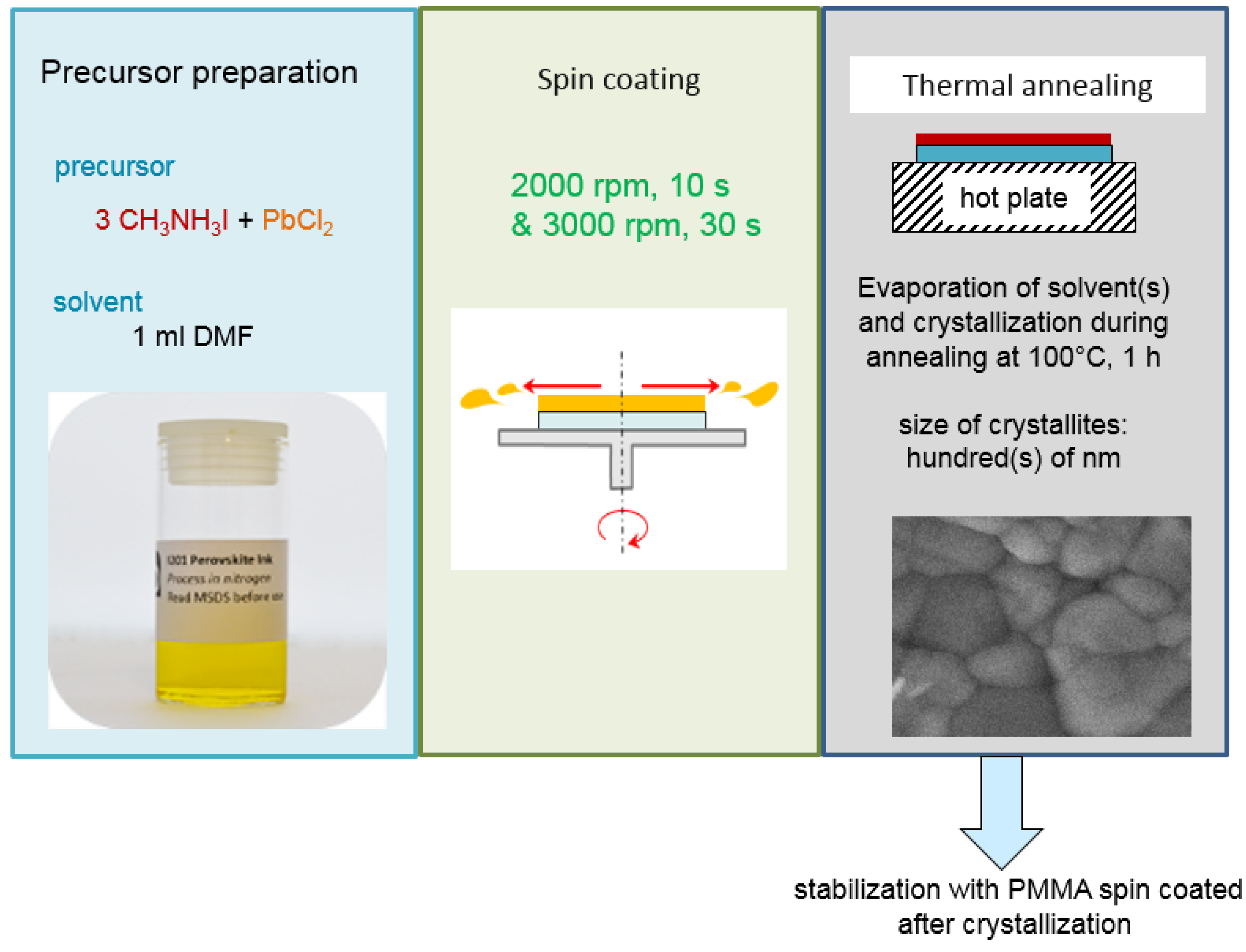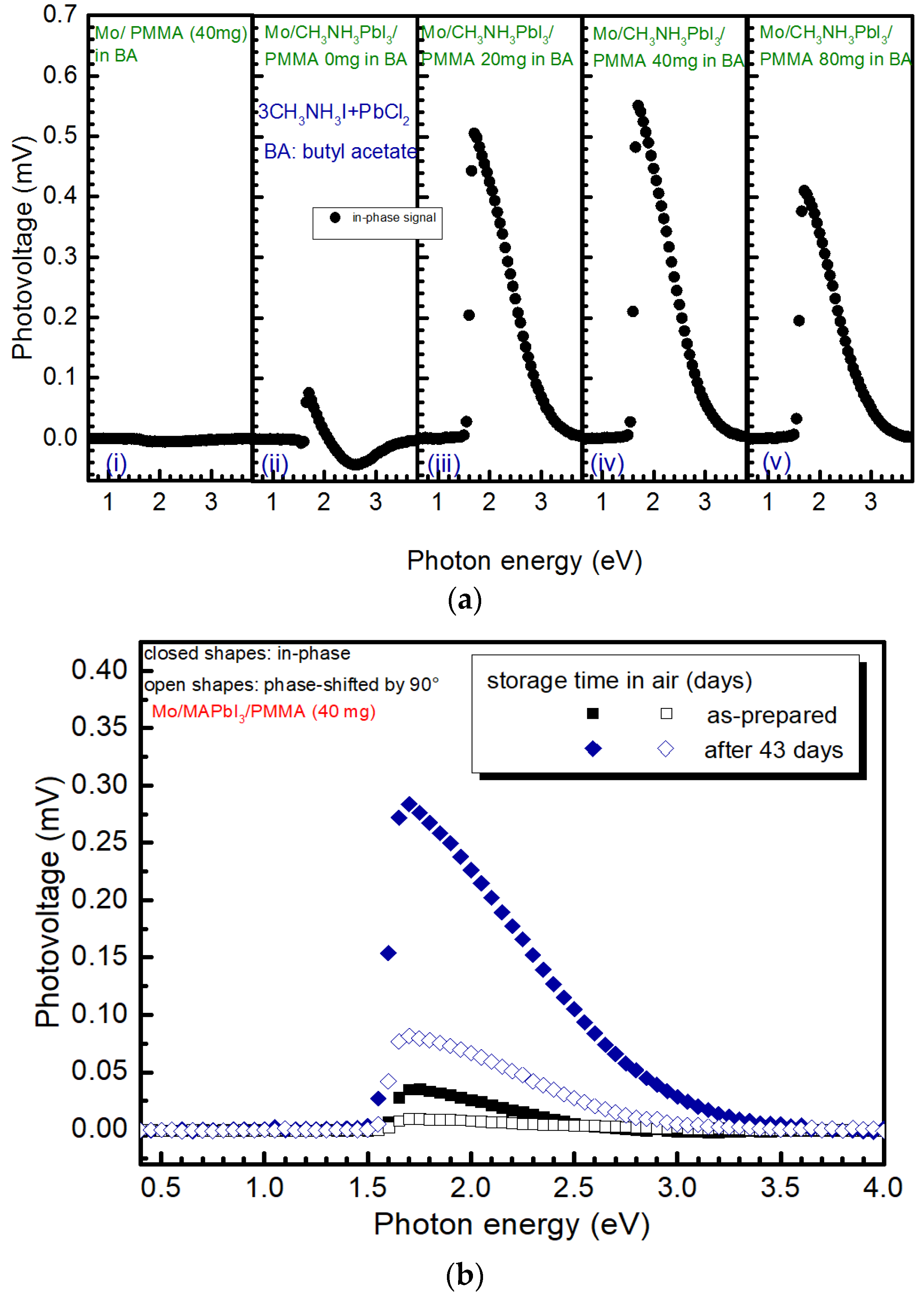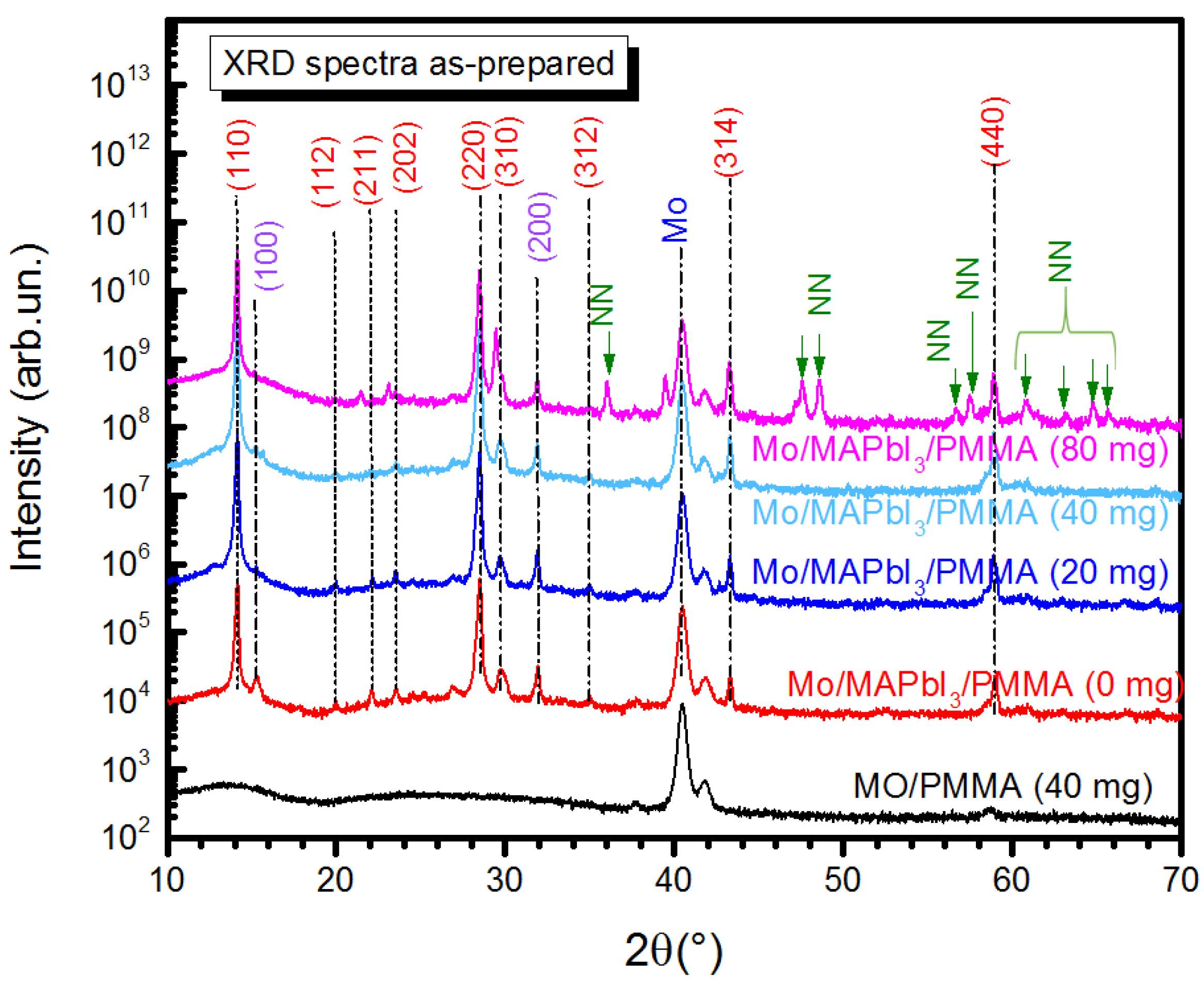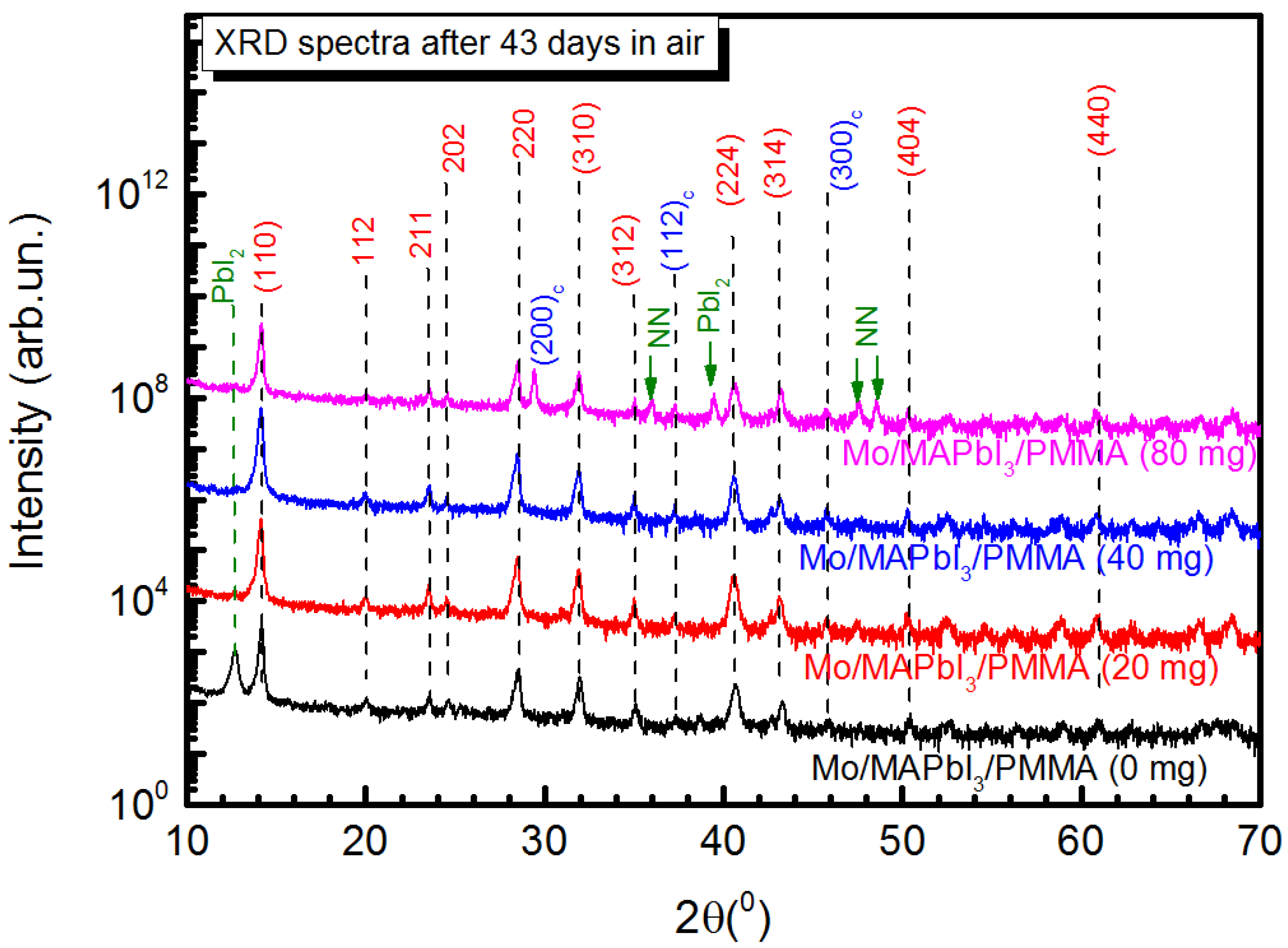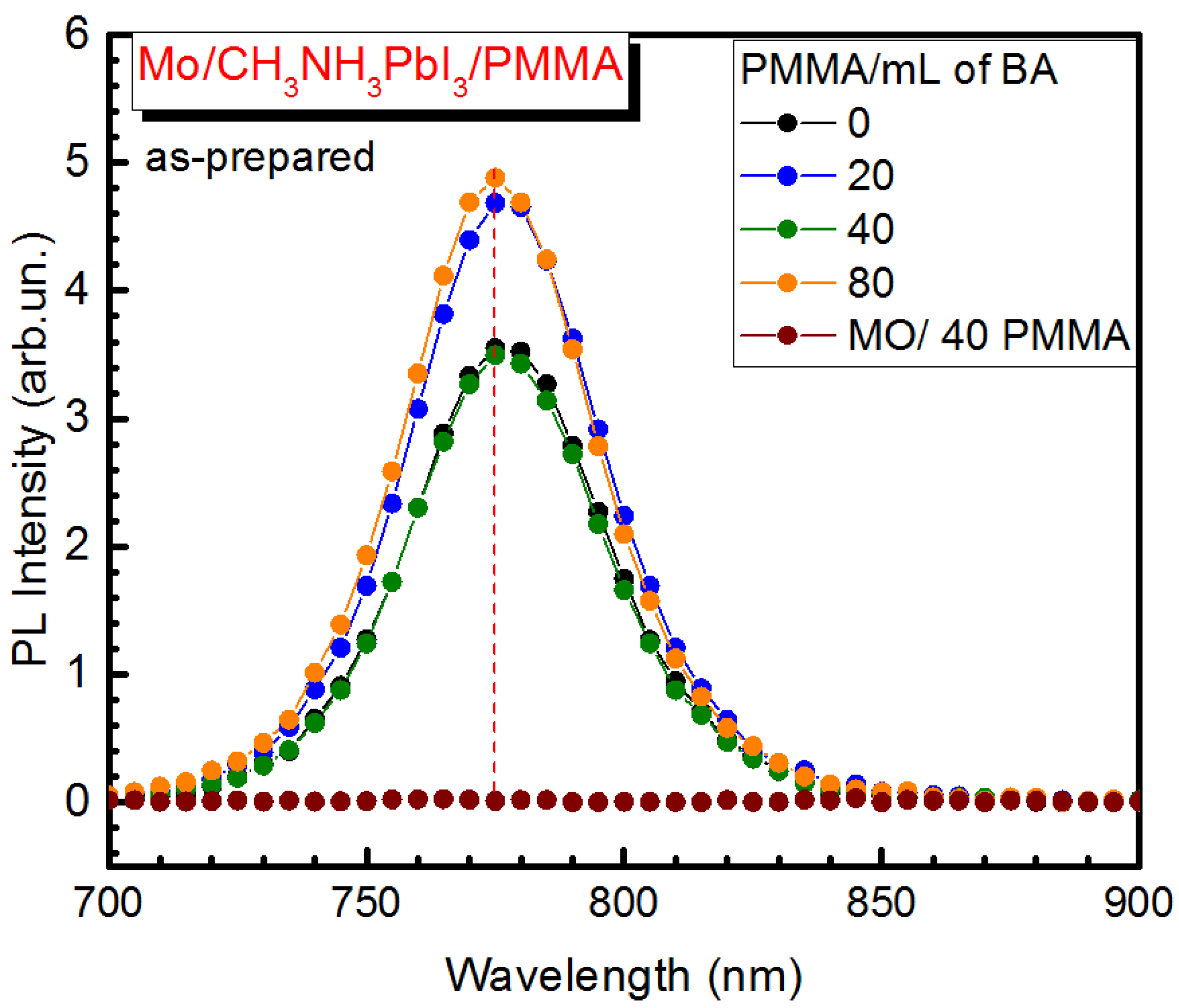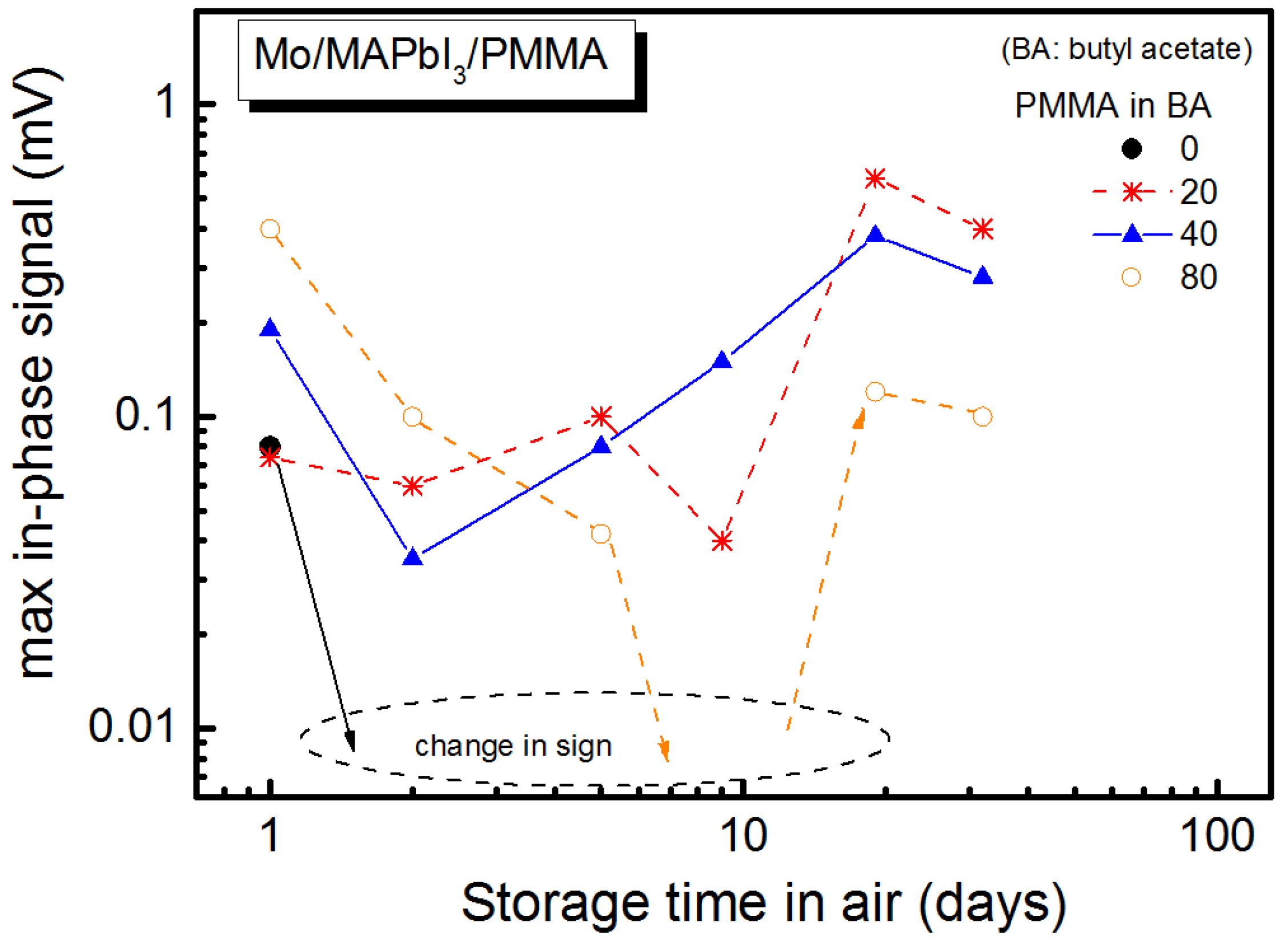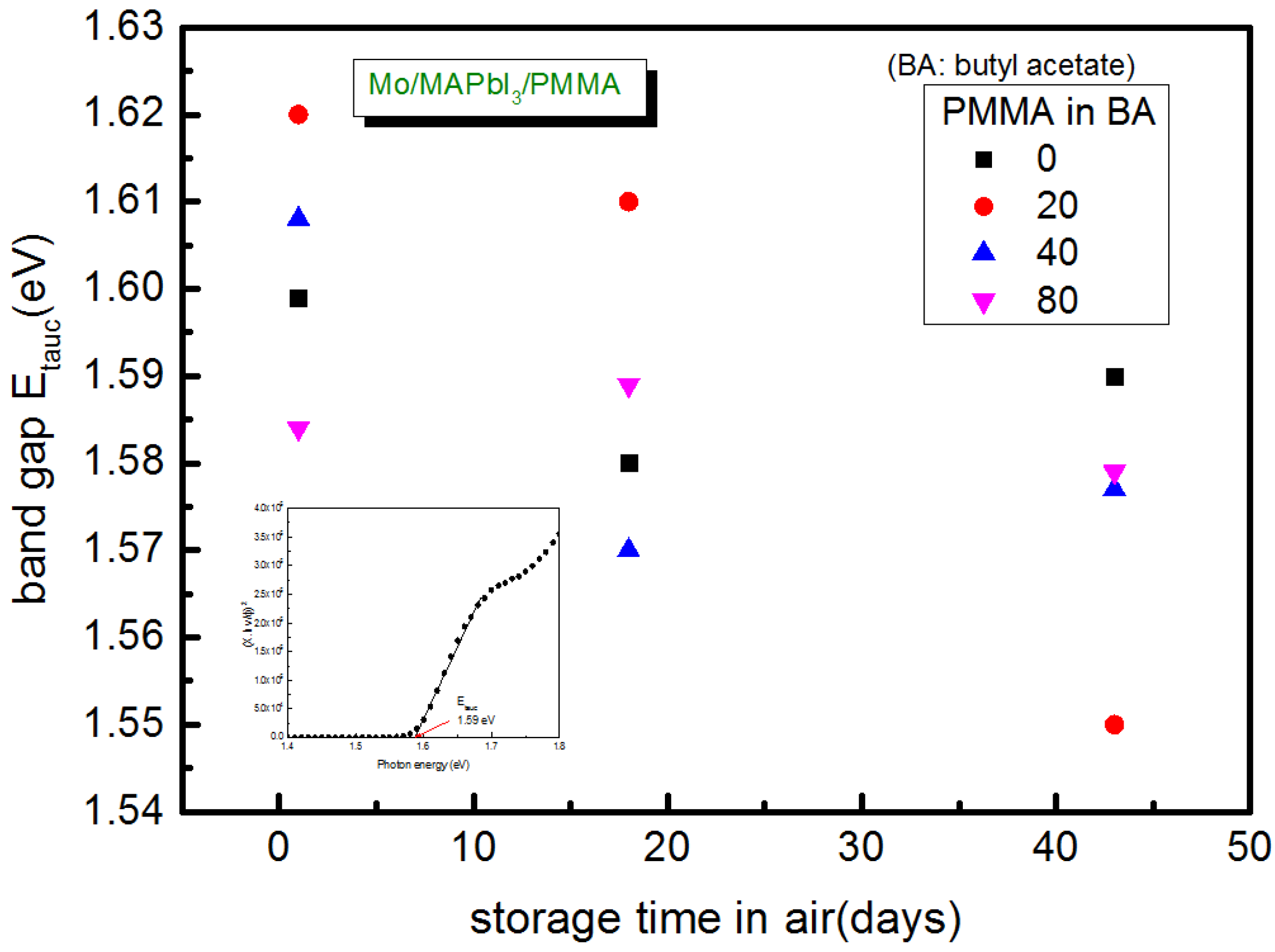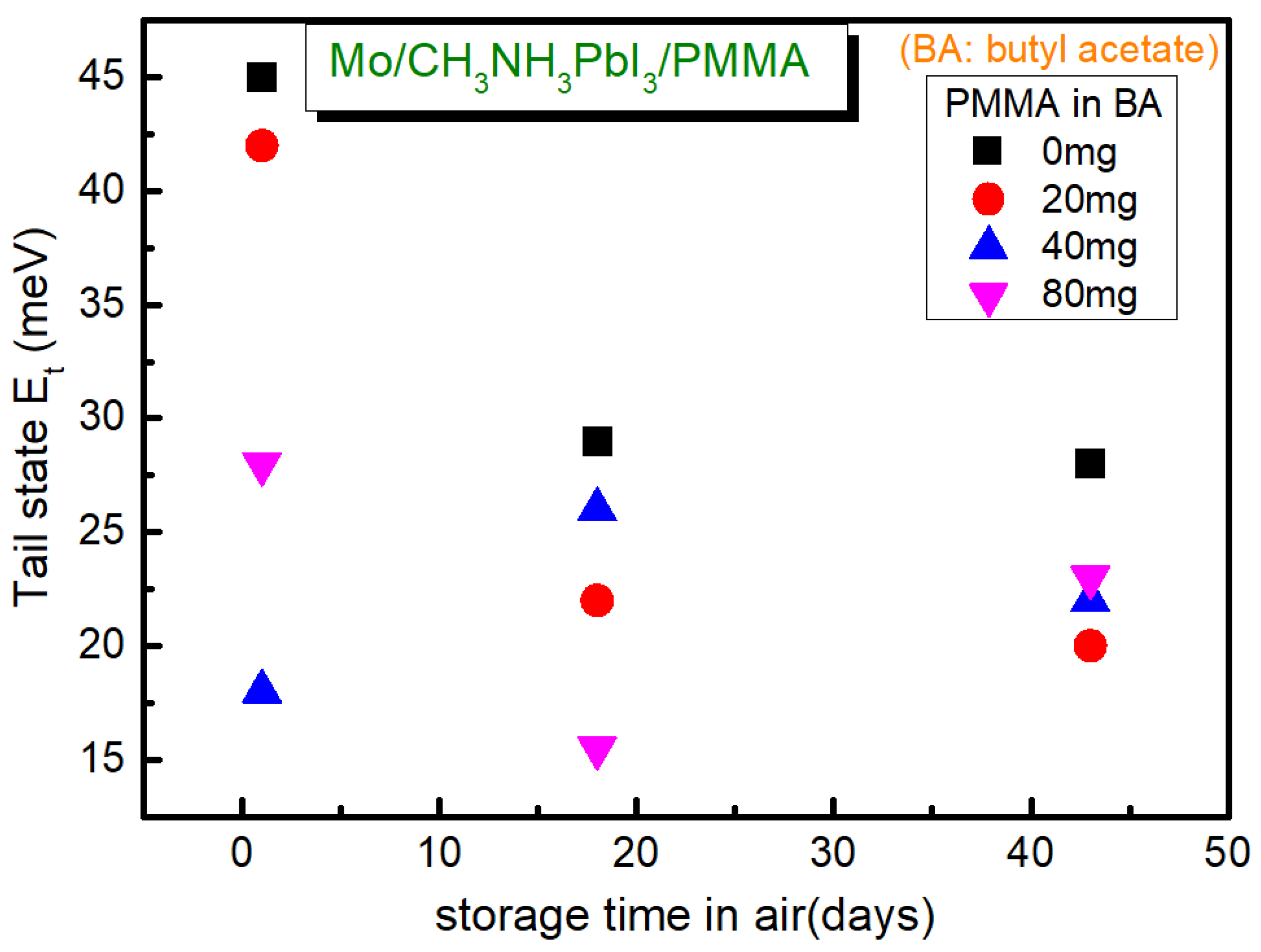1. Introduction
Hybrid organic inorganic perovskite (HOIP), for example, methylammonium lead triiodide (CH
3NH
3PbI
3) possesses several properties such as high absorption coefficient [
1], long carrier diffusion length [
2], ambipolar charge transport [
3], high mobility [
4], as well as the ability to be solution processed via a low temperature deposition method. The low temperature processing approach is useful for energy conservation and can be adopted for large-scale production and in flexible devices [
5]. Spin coating technique is considered as one of the widely used and cheapest techniques for film production method [
6], however, it is difficult to realize uniform and homogenous film through spin coating process. Homogenous film formation is very crucial for high performance of the device since inhomogeneous film enhances recombination of charge carriers. Usually one-step solution process, two-step sequential method, and two-step interdiffusion are the most commonly used deposition approaches with spin coating techniques. Solar cells with the highest efficiencies were obtained using the one-step solution process [
7]. The two-step process has also received considerable efficiencies—of about 15.7%—via low temperature processing [
8], however there is a persistent problem of non-reproducibility due to incomplete reaction of lead iodide which reduces device performance.
Recently, several efforts have been made to enhance the stability of perovskite solar cells. For instance, Zhang et al. combined slow growth of perovskite film and introduced a ZnO interlayer and corresponding devices were highly reproducible with excellent stability [
5]. Quan et al. used density functional theory (DFT) where the intercalation of phenylethylammonium between perovskites introduces van der Waals interactions with increased formation energies which improved device stability [
9]. You et al. also reported on solution-processed perovskite solar cells with NiO
x and ZnO nanoparticles as hole and electron transporting layers with improved stability against water and moisture [
10]. Moreover, introducing bromide into CH
3NH
3PbI
3 formed a mixed combination of CH
3NH
3PbI
3−xBr
x with related devices having improved stability [
11]. Other approaches introduced p-type polymers as protecting layers since the hydrophobicity of the polymers prohibit intrusion of moisture and water into perovskite heterojunction [
12]. Among the polymers used to enhance stability of perovskite is polymethylmethacrylate (PMMA). PMMA is an amorphous, environmentally friendly, and cost effective polymer used in many applications, such as in making aircraft windows. Many researchers have reported on the passivating role of PMMA on perovskite by filling pinholes and surface traps [
13,
14,
15]. Song et al. reported on the use of PMMA in passivating surface traps of electronic devices made of ZnO nanaowires. Passivated ZnO nanowire FET
S maintained their electrical properties under different environmental conditions while carrier concentration and mobility of un-passivated FETs were significantly influenced by the environmental [
13].
Wang et al. reported on the stability and improved performance of perovskite solar cells by inserting a thin layer of PMMA between CH
3NH
3PbI
3 and Spiro-OmeTAD. They obtained power conversion efficiency of 18.1% with the cell maintaining less than 5% decrease in efficiency after 20 days [
15]. The improved performance was due to reduced shunt paths between TiO
2 layer and Spiro-OmeTAD in which PMMA helped to fill the pinholes and grain boundaries in perovskite layer. Wang et al. also reported on the insulating tunnelling behavior of different polymers when inserted between perovskite and C60. The insulating polymer exhibited tunnelling behavior by suppressing charge recombination at contacts by selectively conducting one type of charge while blocking the other type of charge [
16]. Luo et al. demonstrated high quality perovskite films employing PMMA as anti-solvent during spin coating process. PMMA was used to induce nucleation and growth of perovskite crystals [
17].
In this article, we attempt to explore the possibility of improving the stability of perovskite layers by coating them with polymethylmethacrylate (PMMA). The interfacial interactions between perovskite and PMMA of different concentrations were studied. For long term stability, it is important to understand the interface interaction between perovskite/PMMA, so as to gain deeper understanding of the interactions between the two layers and how such interactions could influence electrical and structural properties for the development of stable perovskite based devices. It has been shown that incorporation of PMMA with carbon nanotubes could stabilize CH
3NH
3PbI
3 by inhibiting fast degradation [
12]. Recently, Dittrich et al. reported on the temperature dependence of the band gap of CH
3NH
3PbI
3 stabilized with PMMA using SPV and observed a jump in the band gap at 40 °C corresponding to transition from the tetragonal to cubic phase. In contrast, there was no signature in the band gap for transition from the tetragonal to orthorombic phase and concluded that there were structural interactions between CH
3NH
3PbI
3 and PMMA interfaces [
18]. Charge transport properties and structural properties between perovskite and PMMA were investigated using modulated surface photovoltage spectroscopy (SPV), photoluminescence (PL), and grazing incidence X-ray diffraction (GIXRD). GIXRD allows for the determination of phase structure from lattice planes that are perpendicular to the sample surface while SPV allows for characterization of electronic properties related to charge separation of photogenerated charge carriers, band gap, and defect states close to the band edge at the sample surface. Both GIXRD and SPV have the same order of information depth implying that penetration depth of GIXRD and transport length of photogenerated charge carriers are of the order of hundreds of nm [
19]. Optical properties of perovskite layers have already been studied by photoluminescence (PL) measurements [
20]. PL reveals optical transitions in perovskite films by through the process of radioactive recombination. However, PL spectroscopy requires a laser which can be challenging for its implementation. On the other hand, surface photovoltage spectroscopy has been employed as a complimentary technique to photoluminescence since it gives information about charge separation of photogenerated electrons and holes due to illumination without radiative recombination processes [
20]. SPV, as a technique, is surface sensitive and requires no contact for measurement of charge separation in semiconductor materials [
21]. A modulated SPV signal can be obtained when absorption of incident light is followed by separation of charge carriers. Compared to other methods, modulated SPV spectroscopy can give information on onset energies, change of sign, defect states below the band gap [
22], and can also be applied to measure diffusion length using the method developed by Goodmann [
23]. Furthermore, SPV is very sensitive at low light intensities where charge separation takes place [
18]. SPV can be used to study exponential defect states below the band gap of CH
3NH
3PbI
3 and previous studies showed that the addition of a small amount of ammoniumvaleric acid iodide (AVAI) into solution containing CH
3NH
3I and PbCl
2 leads to a reduction in the value of defects below the band gap, and hence a reduction in the disorder in the material [
24]. The study provides a better understanding of the electrical and structural behavior of CH
3NH
3PbI
3 coated with PMMA to promote development of stable related photovoltaic devices.
2. Materials and Methods
Molybdenum coated glass substrates (23.5 × 23.5 mm2, PVcomB, Berlin, Germany) were sequentially cleaned using an ultrasonicator in detergent (Mucasol, Sigma-Aldrich, Schnelldorf, Germany), distilled water, acetone, and 2-propanol for 15 min each. For each step, nitrogen gas was used to dry the substrates. The cleaned substrates were immediately transferred and stored in a N2-filled glovebox in order to reduce water and O2 adsorption on the substrate surface.
A 40 wt % perovskite precursor solution was prepared by dissolving methylammonium iodide (CH
3NH
3I, Dyesol, Queanbeyan, Australlia) and PbCl
2 (Carl Roth, GmbH & Co. KG, Karlsruhe, Germany) with a molar ratio of 3:1 [
25] in anhydrous N,N-dimethylfomamide (DMF, Sigma Aldrich) and then stirred at 60 °C overnight on a hotplate inside a nitrogen filled glovebox. Measurements of 0, 20, 40, and 80 mg of PMMA were each dissolved in 1 mL of butyl acetate and stirred on a hot plate at 60 °C for 2 h in the glove box. Thin film samples were prepared by spin coating 100 μL of perovskite solution on molybdenum substrate using two-step spin coating parameters of 2000 rpm for 10 s and 3000 rpm for 30 s, followed by annealing on a hot plate at 100 °C for 60 min in a nitrogen-filled glovebox. A warm solution of PMMA at 60 °C (different concentrations in 1 mL of butyl acetate) [
25] was immediately spin coated on top of annealed perovskite films at 2000 rpm for 60 s (see
Figure 1). The perovskite samples coated with PMMA in different concentrations were stored in air and their behavior monitored over a period of 43 days. During this time, grazing incidence X-ray diffraction (GIXRD) and surface photovoltage spectroscopy (SPV) measurements were performed on the samples. Whereas, PL measurements were only performed for as-prepared samples. GIXRD and SPV techniques confirmed that only optimum concentration of 40 mg/mL of PMMA coated on the Perovskite showed no impurity phase, even after staying in air for more than 43 days.
Modulated SPV spectra in the fixed capacitor arrangement [
26] for standard measurements were performed in a spectral range between 0.4 and 4.0 eV for wide range and 1.4–1.8 eV for narrow range with a quartz prism monochromator (SPM2) and a halogen lamp. The wide range helps to determine the overview spectra of the SPV signals while the narrow range helps to determine onset energy, tail states, and approximate band gaps using Tauc plot [
27]. The vacuum pressure was maintained at a base pressure of 2 × 10
−6 mbar. A reference signal from the chopper with a modulated frequency of 8 Hz was fed into a lock in amplifier (EG & G 5210, princeton applied research, Oak Ridge, TN, USA). Lock in amplifier measured the signal from the sample as an x-signal (in-phase) and as a y-signal (phase shifted by 90°). Impedance buffer of high input resistance of about 50 GΩ was used to match the measurement capacitor to the input resistance of the lock in amplifier. To monitor the stability of perovskite films coated with PMMA, SPV and GIXRD measurements were taken for the air stored samples on the day of preparation and after 43 days. The phase structure near the surface of perovskite films deposited on molybdenum substrate and coated with PMMA , kept in air for different days were investigated using grazing incidence X-ray diffraction (GIXRD, Brucker AXS D8 Advance, Karlsruhe, Germany) with Cu Kα radiation using a step size of 0.02° and step time of 4 s. For photoluminescence (PL) measurements, a dye laser with an energy density of 1 mJ/cm
2, pulse length of 5 ns, and a wavelength of 365 nm was used for pulsed excitation. The light was focused onto the sample and a lens collected emitted PL light from the sample. The PL intensity was measured for a wavelength range of 1100–400 nm using an avalanche photodiode with a preamplifier with a bandwidth of 15 MHz. The PL spectral dependent measurements were carried out by a quartz prism monochromator, which detected the signal at a time of 20 ns.
3. Results and Discussion
Figure 2a shows in-phase and phase shifted by 90° SPV spectra for the sample deposited with 40 mg/mL PMMA onto the Mo substrate (i) and for Mo/CH
3NH
3PbI
3 coated with PMMA at concentrations of 0, 20, 40 and 80 mg/mL (ii–v), respectively measured for as-prepared samples. For the sample in which only PMMA was deposited onto the substrate, there were no signals for both in-phase and phase shifted by 90°. This was attributed to the fact that PMMA is an insulator, hence no charge separation occurred. All perovskite samples showed a dominant onset of SPV signals at about 1.5 eV, i.e., at the bandgap of CH
3NH
3PbI
3 [
28]. This correlates well with the existence of CH
3NH
3PbI
3 phase as revealed by the GIXRD measurements. When perovskite was coated with 0 mg/mL of PMMA, in-phase signal was negative then changed sign, becoming positive at photon energy of 1.5 eV, reaches a maximum at 1.7 eV and again becomes negative at photon energies above 2 eV. This might be correlated to the presence of PbI
2 [
21] as detected in the GIXRD measurements (see also
Supplementary Information Figures S1 and S2). For perovskite coated with 20 mg/mL of PMMA, the in-phase signal was positive while the phase shifted by 90° signal was negative, indicating one mechanism of charge separation [
24]. Positive in-phase signal has a maximum height of 0.51 mV at 1.7 eV and for the sample coated with 40 mg/mL of PMMA, both in-phase and phase shifted by 90° signals are positive, showing two mechanisms of charge separation. Photogenerated electrons were separated towards the Mo substrate while holes were preferentially separated towards external surface. The in-phase signal increased from 0.51 mV for 20 mg/mL of PMMA to 0.6 mV at 1.7 eV for 40 mg/mL PMMA. The increase in the value of in-phase signal correlates to the ongoing formation of CH
3NH
3PbI
3 as detected also with the increased GIXRD peak intensity for the same sample. For perovskite coated with 80 mg/mL of PMMA, the in-phase signal is positive while the phase shifted by 90° signal is negative, implying one mechanism of charge separation (i.e., opposite signs of the value of in-phase and phase shifted by 90° signals). The positive in-phase signal height of 0.41 mV has a maximum at 1.7 eV. The in-phase signal decreased from 0.6 mV for 40 mg/mL PMMA to 0.41 mV for 80 mg/mL PMMA. Irrespective of the concentration of PMMA, in-phase signals had a maximum photovoltage at photon energies of about 1.7 eV and onset energy of about 1.5 eV. This implies that increasing concentration of PMMA does not have an influence on the band gap of perovskite, indicating that it only acts as a protective layer on the surface of perovskite because of its excellent hydrophobic properties [
12].
Figure 2b shows the overview spectra of the in-phase and phase-shifted by 90° SPV signals measured for as-prepared sample and after 43 days of storage in air for perovskite coated with PMMA at a concentration of 40 mg/mL. A sharp onset between 1.5 and 1.6 eV was observed for all SPV spectra. During the whole period of measurement, no impure phase, such as PbI
2 phase, was detected.
Close to
Eg for the as-prepared sample, and after 43 days of storage in air, both in-phase and phase-shifted by 90° signals were positive, indicating that photo-generated holes are preferentially separated towards the sample surface while electrons towards the bulk (substrate) [
29]. Furthermore, the phase shifted by 90° signal was smaller in magnitude compared to in-phase signal. This suggests that trapping and de-trapping of charge carriers may lead to a slow response of the SPV spectra [
18]. Since in-phase and phase shifted by 90° signals had the same signs, charge separation was caused by the two mechanisms of charge separation and that relaxation of SPV signals was due to recombination processes [
24].
Figure 3 represents the GIXRD patterns of the Mo substrate coated with 40 mg/mL of PMMA and of CH
3NH
3PbI
3 deposited onto the Mo substrate and thereafter coated with PMMA at concentrations of 0, 20, 40 and 80 mg/mL for the as-deposited sample measured on the day of preparation. Not all samples showed PbI
2 peaks in the XRD patterns, and hence are good for studying the stability of CH
3NH
3PbI
3. PMMA was used as a blocking layer to prevent degradation of the perovskite film [
30]. XRD shows the diffraction peaks at about 14.2°, 20.01°, 23.48°, 24.50°, 28.5°, 31.89°, 43.5°, and 59.0°, which were the characteristic tetragonal peaks of CH
3NH
3PbI
3. These diffraction peaks correspond to (110), (112), (211), (202), (220), (310), (314), and (440) planes of crystalline CH
3NH
3PbI
3, respectively. These results are in good agreement with the previous reports [
19,
31]. There are two dominant peaks at 14.2° and 28.5° in all the samples, indicating the formation of the crystalline perovskite. The peak intensity was relatively high for perovskite coated with PMMA at a concentration of 40 mg/mL. This implies that 40 mg/mL seems to be the optimum concentration of PMMA at which it acts as an efficient blocking layer for preventing the degradation of these CH
3NH
3PbI
3 films [
30]. Since PMMA is an insulator, hydrophobic, and able to prevent the intrusion of moisture into the perovskite layer, concurrently inhibiting the evaporation of methylammonium iodide [
12]. Small diffraction peaks at about 15.7° and 31.8° were also observed for all samples containing perovskite. These peaks could be correlated to the (100) and (200) diffraction peaks of CH
3NH
3PbCl
3 which is in agreement with previous reports [
25]. It was interesting that the coating of PMMA on top of perovskite layer could significantly reduce the amount of CH
3NH
3PbCl
3 in the final perovskite films [
29]. The peak at 40.47° appeared in all the samples even without perovskite. This could be supposed to be due to molybdenum substrate [
31]. It was found that when using 80 mg/mL of PMMA, new peaks appeared at 35.80°, 39.50°, 47.70°, and 48.8°. The peak at 39.50° was identified to be a PbI
2 peak while remaining peaks were non-identified and their meanings have not yet been identified to the best of our knowledge. The appearance of the PbI
2 phase is correlated with the appearance of the SPV signal at about 2.3 eV [
14,
23].
After 43 days of storage in air (see
Figure 4), impurity phase at 12.67° was observed for samples with 0 mg/mL and 20 mg/mL of PMMA coated on the perovskites. For perovskite coated with 80 mg/mL of PMMA, an impurity peak was observed at 39.50° with some extra peaks at 29.42°, 37.45°, and 45.74° corresponding to (200), (112), and (300) cubic phase of perovskite [
32]. This implied that perovskite coated with 80mg/mL of PMMA coexisted in two phases (tetragonal and cubic phases) with continued storage in air. The impurity phases at 12.67° and 39.50° resembled those of PbI
2 and may be due to degradation of perovskite to its constituent precursor elements [
25]. Perovskite coated with 40 mg/mL of PMMA did not show any impurity phase even after storage in air for 43 days. This indicates that 40 mg/mL of PMMA can be the optimum concentration for it to act as a blocking layer. However, for 80 mg/mL PMMA, small impurity phases at 12.67° and 39.50° were observed together with the coexistence of two phases.
Figure 5 shows PL spectra for perovskite coated with 0, 20, 40, and 80 mg/mL of PMMA and for 40 mg/mL PMMA on Mo substrate. The maximum emission was observed at the same wavelength of 775 nm for all perovskite samples. This was consistent with the data reported elsewhere [
33] and corresponds to band gap of about 1.6 eV for tetragonal perovskite phase. For comparison, the Tauc gap obtained using SPV for the sample with 40 mg/mL of PMMA was 1.59 eV (see
supporting information Figure S3) .The PL intensity was increased with increasing concentration of PMMA except for 40 mg/mL, which was highly quenched, indicating radiative recombination process. Quenching in the sample with 40 mg/mL of PMMA might be attributed to fast electron transfer towards the substrate, which is in agreement with the SPV measurement in which both the in phase and phase shifted by 90° signals were positive. The results also agree with the findings by Sun et al. [
34]. There was no PL signal for 40 mg/mL PMMMA on molybdenum substrate, since PMMA is an insulator [
12] hence having no effect on PL spectrum. The band gap of perovskite did not change with concentration of PMMA, suggesting that PMMA only modifies the surface of CH
3NH
3PbI
3 without changing the bulk crystal.
Figure 6 shows maximum in-phase SPV signals on a logarithmic scale when the samples were stored in air for 43 days. Perovskite coated with 0 mg/mL of PMMA, a change of sign after the first day of storage in air was observed and an impurity phase of PbI
2 at around 2.3 eV [
21] appeared as the storage time in air increased. This implied that perovskite degraded to PbI
2 with CH
3NH
3I evaporating from the surface due to interaction with air and moisture [
29]. This was also confirmed by the GIXRD spectrum that PbI
2 peak appeared at 12.67° [
25] after exposure to air for more than one day. On the other hand, for perovskite coated with 20 mg/mL of PMMA, there was no change of sign, but the sample shows variability in the value of maximum in-phase signal. This implied that the sample was not stable and hence not suitable for studying stability test. Interestingly, perovskite coated with 40 mg/mL PMMA showed no change of sign in the value of in-phase signal, but showed a drop in the value of the in-phase signal on the second day by more than one order of magnitude. After the 2nd day until 18th day, the signal increased, before a slight drop was observed on the 43rd day of storage in air. The decrease of the signal might be due to degradation when the sample was exposed to air initially, thereafter with continued exposure to air there was passivation of surface defects. Finally, for perovskite coated with 80 mg/mL of PMMA, there was a change of sign on the 18th day of storage in air. The change of sign might be correlated to many processes contributing to charge separation, including the appearance of impurity phases.
Figure 7 shows a Tauc plot [
27] as a function of storage time in air.
Etauc decreased monotonously with increasing storage time in air except for 80 mg/mL of PMMA, which showed a slight increase in band gap from 1.584 eV on first day to 1.589 eV on the 18th day of storage in air, before decreasing to 1.587 eV on the 43rd day of storage in air. The 20 mg/mL PMMA showed a wide band gap of more than 1.6 eV as compared to other samples during the first 18 days and smallest band gap of 1.55 eV after 43 days in air. Previous reports indicate that the band gap increases with the decrease in concentration [
26] and this is in agreement with our findings on initial days in which 20 mg/mL of PMMA had the widest band gap while 80 mg had the narrowest bang gap. In contrast, for 0 mg/mL, only solvent was used with no PMMA concentration. After 43 days in air, 20 mg/mL PMMA revealed the narrowest band gap, which might be due to impurity related defects. There is a shift in band gap towards lower energies with an increase in storage time in air. This could be postulated to be due to different chemical and surface reactions between CH
3NH
3PbI
3/PMMA interfaces with air.
Figure 8 shows the tail states of Mo/ CH
3NH
3PbI
3/PMMA as a function of storage time in air. During the first day, the 0 mg/mL sample recorded the highest tail states of 45 meV. This might be attributed to intrusion of moisture related impurities into the film due to absence of PMMA that acts as a protective layer. Moreover, 20 mg/mL had a tail state of 42.5 meV which was still quite high as compared to 80 mg/mL with 26 meV. The 40 mg/mL sample had the least amount of tail states of about 18 meV which is comparable to an Urbach tail energy of 15 meV obtained by De Wolf et al. [
1]. It was also observed that tail states decreased with continued storage in air and this can be attributed to increased surface defect passivation.
